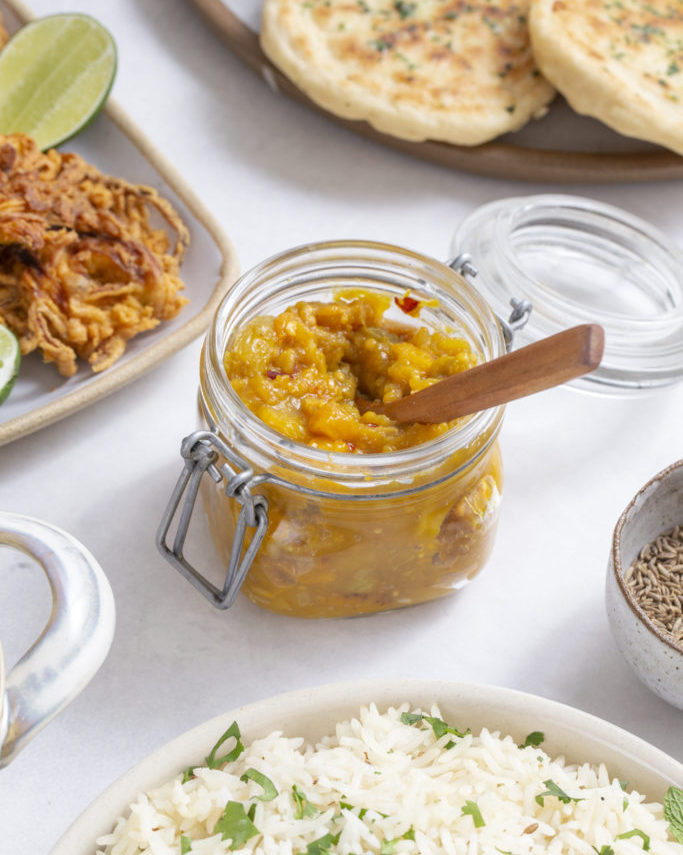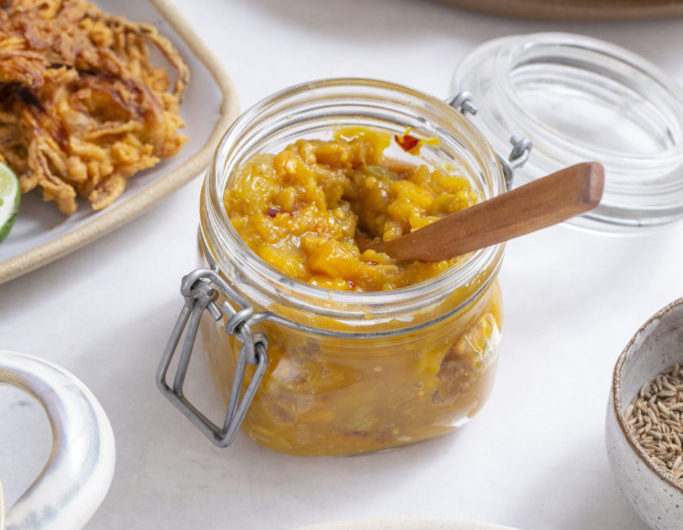Sweet, sticky, savory, and slightly spicy – it must be our magnificent easy-to-make mango chutney!
It’s the perfect condiment to accompany Indian dishes, and is traditionally used as a dip for naan bread, onion bhajis, and pakoras, while we also love to use it as a sauce to liven up sandwiches, wraps, and burgers.
For this delicious recipe, we use easy-to-find, whole-food ingredients like fresh mango, ginger and chili to make a chutney that’s healthier (and tastier!) than store-bought versions.
Heads up: This post contains affiliate links! If you buy something through one of those links, you won’t pay a penny more, but we’ll get a small commission, which helps keep the lights on. Thank you! 🙂
Table of contents

What is Mango Chutney?
Mango chutney – which comes from the Hindi word ‘catni’ (which means ‘to lick’!) – can be described as a sweet and savory, jelly-like mix of mangos, spices and vinegar.
It is commonly used as a condiment in Indian cuisine, and particularly popular in countries like Great Britain.
Mango chutney really is a taste sensation. The mango is naturally sweet, while the presence of chili, garlic, ginger and onion adds complexity.
Is Mango Chutney Vegan?
Yes! Of course, some store-bought mango chutneys may contain colorings or flavorings that are not vegan, but our recipe is entirely plant-based.
Is this Mango Chutney Gluten-Free?
It is! There are no glutenous ingredients in this recipe, so it’s ideal if you are living a gluten-free life.
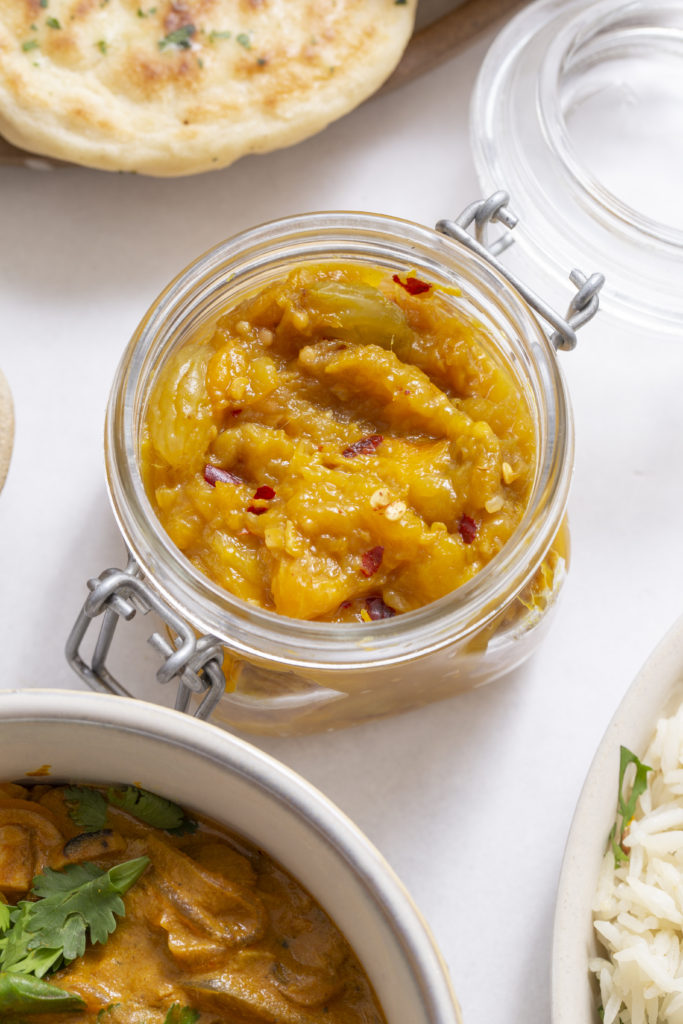
Is Mango Chutney Easy to Make?
Yes – it takes around an hour and a quarter to make. Aside from some chopping, the bulk of the time is spent watching the ingredients cook together over low heat.
What is Mango Chutney Made Of?
For this recipe, we use a combination of easy-to-find, fresh ingredients and kitchen essentials.
You will need the following ingredients:
- Coconut sugar
- Apple cider vinegar
- Mangos, raw
- Onions
- Ginger
- Garlic
- Mustard seeds, whole
- Red chili flakes
- Water
- Golden raisins (optional)
If you want a sugar-free mango chutney, you can use monk fruit instead of coconut sugar!
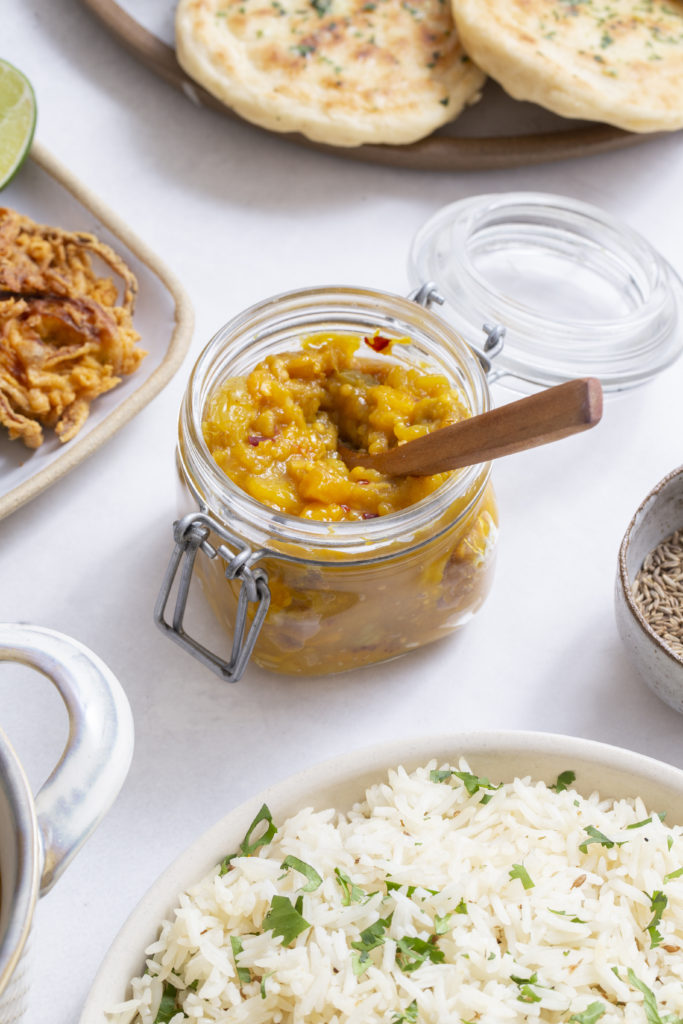
How to Make Mango Chutney
Start by preparing your ingredients. Peel the mangos and dice them small.
Begin making a sugar-vinegar syrup by combining the coconut sugar (or monk fruit) and apple cider vinegar in a saucepan.
Bring the mixture to a boil, and stir until the sugar dissolves.
Add the rest of the ingredients into the pan and cook over a low heat, uncovered, for 45 minutes to one hour. Stir it occasionally, until it has a thick, almost syrupy consistency.
When ready, allow it to cool to room temperature, then serve. Pour the chutney into sterilized jars, and seal.
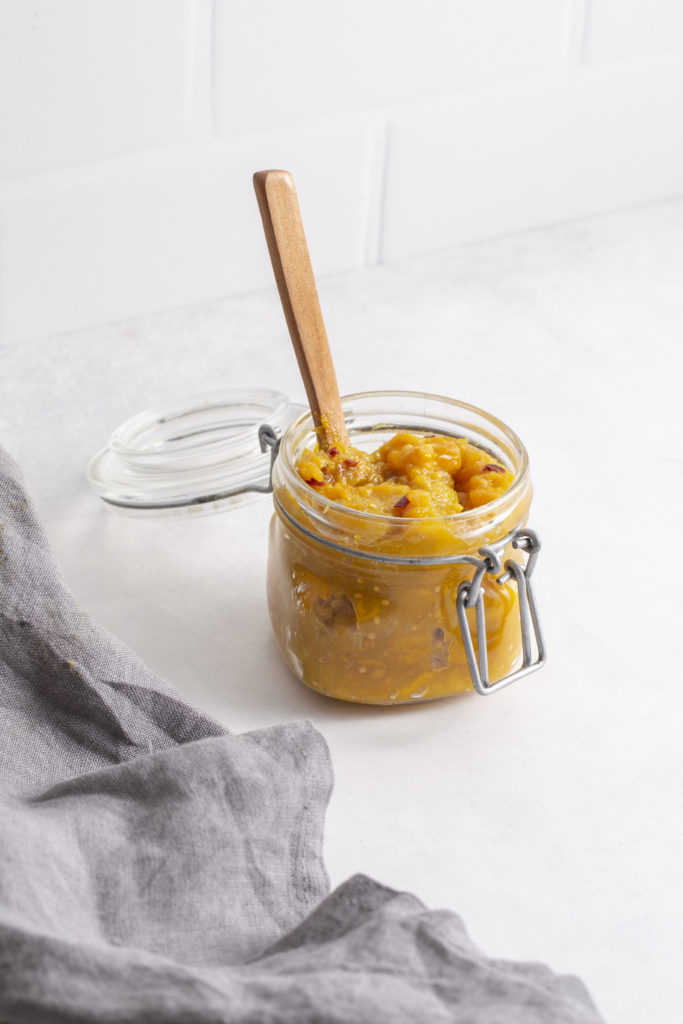
Tips for the Best Mango Chutney
As with all our recipes, the quality of your fresh ingredients will make a difference to the final flavors in your chutney. Where possible, use fresh Alphonso mangos (known as the King of Mangos), fresh ginger, and an organic apple cider vinegar.
The ripeness of the mangos you use can also make a difference to the final chutney.
We use either semi-ripe mangos, which deliver a tartness that offsets the sweetness a little and are also easy to dice, or ripe mangos for a sweet blast!
Be patient during the cooking process. It can be tempting to turn the heat up, but cooking on a low heat will allow the chutney to reduce and thicken to the right consistency.
You can add more chili if you prefer your chutney with more of a kick. Add gradually and taste as you go – remember, it’s easy to add in, but difficult to remove!
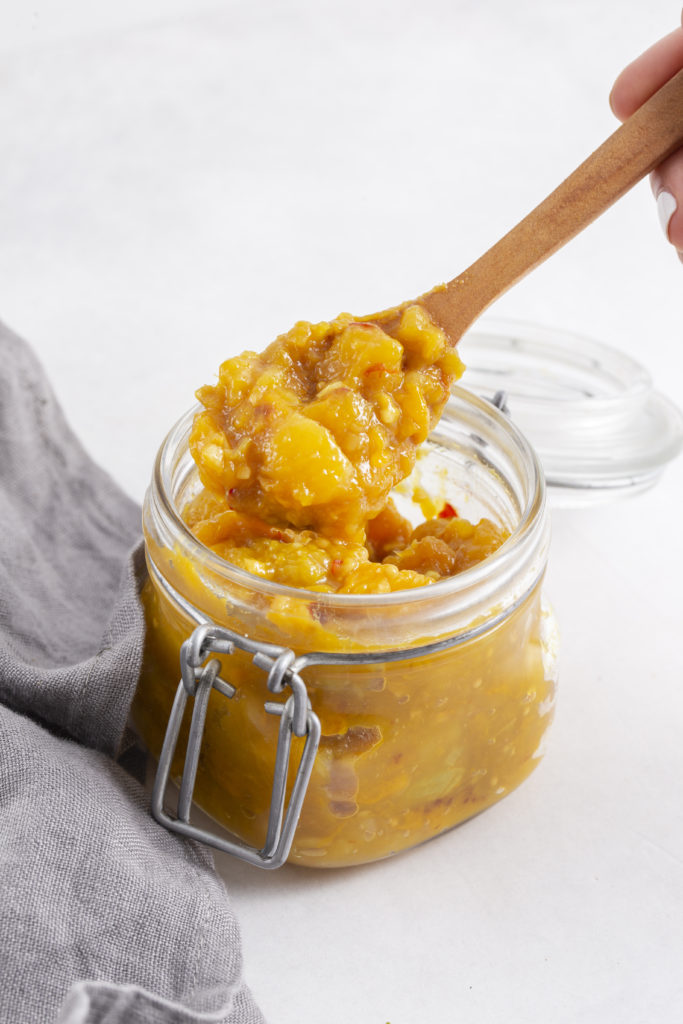
FAQ
How to Store Mango Chutney
After the chutney has cooled, transfer the mixture to sterilized airtight jars, then store in the refrigerator for up to 2 months. Once the jar has been reopened, use the chutney within 2 weeks.
Can You Freeze Mango Chutney?
While it’s feasible, we don’t recommend freezing this chutney, as freezing it affects the consistency and overall quality.
Can You Make Mango Chutney Ahead of Time?
You certainly can! Providing you store it in a sealed jar in the refrigerator, you can make it up to 2 months ahead of time (see storage instructions above).
How Long Does Mango Chutney Last?
When stored in a sealed and sterilizer jar in the refrigerator, this mango chutney will last for up to 2 months. When the jars have been reopened, it will last for around 2 weeks.
What is Mango Chutney Used For?
There is no one purpose to mango chutney!
Traditionally, it is used to accompany Indian dishes like curries, as well as snacks like pakoras, onion bhajis, naan bread, and papadums.
You can also use it as a spread for burgers, sandwiches and wraps, particularly if you are going for an Indian theme (or just want a bit of sweet spice to accompany your usual fillings!).
However, you can also just enjoy this chutney spread thickly on bread or crackers.
If you’re looking for recipes to serve with this mango chutney, check out:
If you try this recipe, let us know! Leave a comment, rate it, and don’t forget to tag your photos with @healthiir on Instagram!
Mango Chutney
Course: CondimentCuisine: IndianDifficulty: Easy6
servings15
minutes1
hourIngredients
¼ cup coconut sugar (or monk fruit for sugar-free)
1 cup apple cider vinegar
4 mangos, raw (about 1lb)
1 cup onions, chopped
¼ cup ginger, finely chopped
1 clove garlic, chopped
1 tsp mustard seeds, whole
¼ tsp red chili flakes
1 cup water
½ cup golden raisins, optional
Directions
- Start by preparing your ingredients. Peel the mangos and dice them small.
- Make a sugar-vinegar syrup by combining the coconut sugar (or monk fruit) and apple cider vinegar in saucepan.
- Bring the mixture to a boil, stirring until the sugar dissolves.
- Add the rest of the ingredients into the pan and cook over low heat, uncovered, for 45 minutes to one hour. Stir it occasionally, until it has a thick, almost syrupy consistency.
- When ready, allow it to cool to room temperature, then serve. Pour the chutney into sterilized jars, and seal for storage.

